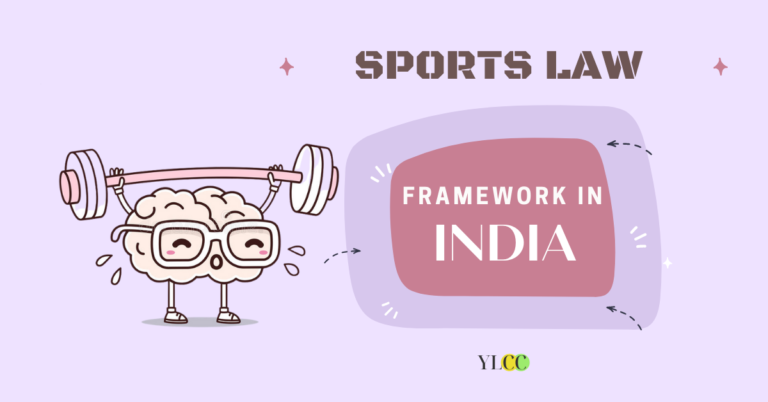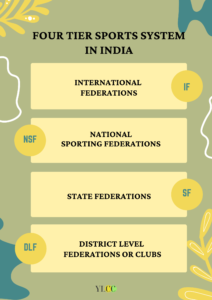
Introduction
“It is plausible to claim that the drafters did not imagine a state of events where an Indian private entity would regulate activities within its field of activity with a strong public character and as pervasively as Government regulation.”
Sports in India is no longer an activity of leisure, it is turning into a serious career prospect for several individuals. With this change, both bodies and associations governing their respective sports are becoming more aware and attempting to bring about revolutionary changes through educating and inspiring young minds. With significant growth in international sports, some of the development has also trickled down to the Indian sports scene. With its increasing importance and relevance, it becomes essential to discuss who regulates the sporting regime in India and how. This article aims to provide an overview of the sports law framework in our country along with a brief insight on the international laws that India is subject to.
The constitutional framework of sports law
Under the Constitution of India, sports have been included under the state list as Entry No. 33 of the seventh schedule. This means that any regulation of sport is to be conducted by the state authorities.
The constitutionality of the National Sports Development Code of India, 2011 was questioned before the court by the Indian Olympic Association in the case of Indian Olympic Association vs Union of India, wherein one of the purposes of the code was to make sure that at the national and international level (which includes meeting the international treaty obligations), sports development falls under the realm of the Union Government under its residuary powers within Entry No. 10 and 13 of the Union List.
The Supreme Court held the particular provision unconstitutional and thus, the central government has no locus standi to legislate on sports. It can be concluded that every state has exclusive competence over sports within their territory i.e. in the state/province and this makes it difficult to address reforms relating to sports law at the national level.
Structure of sports governance

The four-tier system
The current model on which sports regulation is based originates from the European model and can be referred to as the ‘pyramid’ structure of regulation. The model organizes sports and regulatory bodies associated with it.
The Indian sports model which comprises a four-tier system is explained as follows:
- At the top of the system are the International Federations (IFs) such as Badminton World Federation (BWF), International Federation of Association Football (FIFA) and the International Olympic Committee (IOC). These federations serve as the chief regulatory bodies and are uniquely associated with different sports and events. The federations’ key functions include formulating rules, mandates, and guidelines relating to a particular sport, framing policies, analyzing the requirements, and determining the conditions that must be followed by other sports regulating bodies that fall under them. Along with this, they also have the responsibility to organize championships at the international level and to decide the playing rules, penalties, eligibility criteria, and other related aspects of the game.
- Under the international federations, we have the National Sporting Federations (NSFs), whose function is to govern sports at the national level, and thus, they have the responsibility to decide everything relating to sports at the domestic level. This responsibility gives them a significant amount of independence and power. Some examples of NSFs are Athletics Federation of India (AFI), Indian Olympic Association (IOA) and All India Football Federation (AIFF).
Usually, activities like domestic management, revenue collection, and advertising are undertaken by NSFs. One sphere for which the NSFs are primarily responsible is promotion. With each sport and country, their number varies and they are strictly bound by the IFs and their direction.
For regulation of NSFs, guidelines, and notification are issued by ‘The Ministry of Sports and Youth Affairs’ from time to time. Set up by the government of India, the ministry promotes capacity building and creates the infrastructure for inviting wider participation in sports and various competitive events at the international and national levels.
- Under NSFs come State Federations (SFs) which are responsible for conducting activities relating to sports and managing it at a state level. The most important function of the SFs is promoting sports because as federations of the state, they can better understand the needs of the people of their respective states. For effective promotion, these federations try to negotiate and request small funds and manage them.
- The club is the basic unit at the grass-root level. District level federations (DSFs) or clubs come under the SFs and they ensure the efficacy and efficiency of the policies at the district level. They may also vested with the responsibility of organizing and host local sporting events and spreading awareness about the sport.
Registration under Societies Registration Act XXI
Under the Societies Registration Act XXI 1860, all the sport governing bodies are registered as societies. After the registration, the societies become eligible to get government aid in many forms, like BCCI getting tax benefits in form of indirect financial aid or NSFs getting direct financial assistance. It is to be noted that direct financial aid can be given only after a governing body has an observer appointed by the government. The function of the observer is overseeing the bodies’ internal functions like the selection of teams, utilization of funds, etc.
Sports Regulating Bodies in India
Sports Authority of India
The Sports Authority of India (SAI) was set up as a registered society on 16 March 1984 up by the Government of India. It was set up for carrying forward the sports infrastructure of the IX Asian Games first held in 1982 in Delhi. It carries twin objectives: first is the promotion of sports, and second, showcasing sporting excellence at the international and national level. SAI provides training to many athletes along with which it also operates many schemes, implemented through its several regional and training centres for the development and identification of young talent in the field of sports.
National Sports Policy
Formulated in 1984, The National Sports Policy aimed to raise the standards of sports in the country. But because of improper implementation of the policy, the National Sports Policy was again drafted in 2001 to reformulate the 1984 policy. Thereafter, revised guidelines were issued for National Sports Federations (NSFs) assistance along with the issuance of follow-up guidelines from time to time.
These guidelines are legally binding on the National Sports Federations (NSFs) and the National Olympic Committee (NOC), i.e., the Indian Olympic Association (IOA), in case they want to control and regulate sports in India or use the country’s name or represent it nationally or internationally or they want several concessions and benefits. The state sports federations also have to comply with such guidelines.
Sports Law and Welfare Association of India
The Sports Law and Welfare Association of India (SLAWIN) is a national, non-profit, and professional organization. It works with the common objective of understanding, advancement, and ethical practice of Sports Law in India for the promotion of Sports and provides consultancy on various matters like general sport and law issues, regulation of sports governing bodies, intellectual property issues in sport, etc.
Sports Broadcasting Signals (Mandatory Sharing with Prasar Bharati) Act, 2007
The Sports Broadcasting Signals (Mandatory Sharing with Prasar Bharati) Act was passed in 2007 to provide a significant amount of viewers with an opportunity to watch sporting events of national importance through mandatory sharing of broadcasting signals relating to sports with Prasar Bharati and for matters connected with it or incidental to it.
According to the Act, without sharing the live broadcasting signal with Prasar Bharti at the same time, live television broadcasts of sporting events of national importance on any cable or Direct-to-Home network or broadcast radio commentary is not allowed to be carried out by any television holder or content rights owner or any radio broadcasting service provider.
Anti-doping provisions
World Anti-Doping Agency (WADA)
World Anti-Doping Agency was established on 10th November 1999 by the International Olympic Committee. The purpose of the agency is to protect the fundamental right of athletes to participate in a sport that is doping-free and thus promoting fairness, equality, and health for athletes across the world.
In 2003, the agency also adopted a document, i.e. the World Anti-Doping Agency Code (WADC) 2015 with an aim to harmonize the anti-doping policies in all sports and all countries in the world. The latest amendment in the code was in 2021. The code is a non-governmental document and applies to sports organizations only.
Key activities of WADA include carrying out scientific research, developing anti-doping capacities, monitoring the WADC, and imparting education to raise awareness and decision-making capability so that intentional, as well as unintentional anti-doping rule violations, can be prevented.
Agreements of which India is a signatory
India is a signatory to the UNESCO International Convention against Doping in Sport along with 190 other countries which came into force on 1st February 2007. The Convention helps to harmonize at the international level, the anti-doping legislation, regulations, guidelines, and rules with an aim of providing an equitable and fair playing environment for all athletes across the world. The convention also provides a degree of flexibility to governments of its signatory countries as to giving effect to the convention by the way of regulation, policies, legislation, or administrative practices.
India is also a signatory to the Copenhagen Declaration on Anti-Doping in Sport that is a political document through which governments indicated their intention of formally recognizing and implementing the WADC.
National Anti-Doping Agency (NADA)
As a registered society, the National Anti-Doping Agency of India (NADA) was set up by the Government of India on 24 November 2005 with a vision of having ‘doping-free’ sports in India. The national organization is responsible for promoting, coordinating, and monitoring the doping control program in all its forms.
Primary functions of NADA include promotion of anti-doping education and research, maintaining cooperation with other sports and anti-doping-related organizations, fostering reciprocal testing between National Anti-Doping Organizations, and Adopting and implementing anti-doping policies and rules in accordance with the World Anti-Doping Code.
The territorial jurisdiction of sports federations
The territorial jurisdiction of a federation helps in deciding the sports-related issues. When we see at the level of national policy, it is clear that sports are at par with public health and public education, and thus, sport is a public good, and the development of sports is a public function. It is to be noted that the national sports bodies have an autonomous nature.
The National Sports Development Code of India (NSDCI), 2011 is the code that lays down that the territorial jurisdiction of national sports bodies fall under the writ jurisdiction of High Courts under Article 226 of the Indian Constitution as state-like functions such as selecting national teams or representing the country at sports events held internationally are being performed by them.
The BCCI i.e. Board of Control for Cricket in India is a governing body for cricket in India. It comes under the jurisdiction of the Ministry of Youth Affairs and Sports. Headquartered in Mumbai, India, it was founded in the year 1928 and is currently headed by cricketer and former Indian captain Sourav Ganguly.
Rules which are formulated by the WADA are being strictly followed and applied by the BCCI and testing of players has to be done on a regular basis. The Apex Court in the case of Zee Telefilms Ltd. v. Union of India held that national sports bodies like BCCI do not come under the purview of the state within the meaning of Article 12 of the Indian constitution. It was also held that any government control over BCCI is regulatory and not pervasive in nature. Therefore, it can be held liable for its action.
Governance of professional sporting clubs or leagues
A sporting club cannot perform a function where it affects the relations between the community at the national level and the sports-associated persons. In this way, a professional sporting club/league can be distinguished from bodies governing sports.
As of now, more than 12 professional leagues exist in our country with each of them being at different levels of evolution. Some of the prominent sporting leagues are The Indian Premier League, Hockey India League, Indian Super League, and Pro-Kabaddi League.
Not surprisingly, the Indian Premier League (IPL) is the most established of all the national professional sports leagues in India. Financial assistance is given by BCCI along with a committee under the BCCI with its Governing Council. It can be said that it comes under the authority and control of BCCI.
In a landmark case, the Apex Court pointed out a differentiation between match organisers like the Cricket Association of Bengal who have a mandate to promote the sport, and the business organisations who have an objective of only the maximisation of profits by telecasting games. Thus, it can be said that the decisions of professional leagues would be outside the scope of judicial review but IPL is an interesting exception to this rule.
It was held by the Apex Court that the BCCI has a duty to prevent fraud in sports along with maintaining the public faith in the sporting values, which would include the situations characterized by an apparent conflict of interest.
This demonstrates that the public nature of functions applies regardless of the structure or formality of an event. This can have severe implications on organizations like the Amateur Kabaddi Federation of India that operate on a small scale and may be called upon to monitor the Pro Kabaddi League. The league is operated by a private corporation but has been sanctioned by the Federation.
Conclusion
It is important to recognize that sports law is of national significance, besides its utility in personal recreation. It is unfortunate that a country like India which is emerging in the field of sports does not have single uniform legislation dealing specifically with regulation of sports. This warrants discussions and deliberations on a broader spectrum with active participation of common citizens and stakeholders.
YLCC would like to thank Aditi Aggarwal for her valuable inputs in this article.







